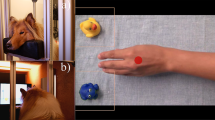Summary
For navigation, desert ants apply piloting and dead-reckoning strategies based on terrestrial and celestial visual cues, respectively. Visual spatial memories, rather than general concepts derived from landmark constellations, are most probably used to define points on earth by nearby landmarks. The visual field of a specialized dorsal part of the ant's retina is mapped on to the celestial sphere to consider the possibility that similar mechanisms are used to define directions on earth by exploiting skylight patterns present at infinity.
Similar content being viewed by others
References
R. Wehner, J. comp. Physiol.77, 256 (1972); T. S. Collett and M. F. Land, J. comp. Physiol.100, 59 (1975).
The literature on homing by use of landmark memories is summarized in R. Wehner, Handbook of Sensory Physiology, vol. VII/6B, Vision in Invertebrates. Springer, Berlin, Heidelberg, New York, in press.
The experiments described here were performed near Maharès, Tunisia (34.58° N, 10.50° E) during summer 1976. They are only part of a larger project on ant homing by the use of landmark cues (‘piloting’) (R. Wehner et al., in preparation).
G. van Beusekom, Behaviour1, 195 (1948); A.M. Anderson, J. comp. Physiol.114, 335 (1977).
The zero-point is defined as that point within the testing area that marks the position of the nest in the training area.
As an additional control experiment has assured, the ants can well be trained to the zero-point of the landmark configuration shown in figure 1, b.
The retention of landmark memories has been tested by keeping individual ants isolated in the dark for up to 10 days. They still exhibited homing capacities similar to those shown in figure 1, a.
R. Wehner and P. Duelli, Experientia27, 1364 (1971); P. Duelli and R. Wehner, J. comp. Physiol.86, 37 (1973). Of course, in order to define ‘home’, a dead-reckoning (vector navigation) system has also to rely on some means of measuring distances.
R. Harkness and R. Wehner, Endeavour, N. S.1, 115 (1977).
R. Weiler and M. Huber, in: Information Processing in the Visual Systems of Arthropods, p. 287. Springer, Berlin, Heidelberg, New York 1972; P. Duelli, J. comp. Physiol.102, 43 (1975); R. Wehner, Fortschr. Zool.23 (1), 148 (1975); and unpublished data.
P. L. Herring, Cell Tissue Res.169, 247 (1976).
F. Räber, Thesis, submitted to the University of Zurich. For a corresponding analysis in bees see E. Sommer, Thesis, submitted to the University of Zurich.
For some general rules about how insects could determine compass directions by skylight cues at any time of the day see K. Kirschfeld, M. Lindauer and H. Martin, Z. Naturforsch.30c, 88 (1975), and S. Rossel, R. Wehner and M. Lindauer, J. comp. Physiol.125, 1 (1978). What the concept of visual spatial memory would imply in that respect is that the ant would have to be able to rotate a stored image in its head (by 15°/h about the north-south axis of the celestial sphere; the latter is not shown in figure 2).
Author information
Authors and Affiliations
Additional information
Supported by the Hescheler Foundation (Zurich) and the Swiss National Science Foundation grants Nos 3.529-0.75 and 3.313-0.78.
Rights and permissions
About this article
Cite this article
Wehner, R., Räber, F. Visual spatial memory in desert ants,Cataglyphis bicolor (Hymenoptera: Formicidae). Experientia 35, 1569–1571 (1979). https://doi.org/10.1007/BF01953197
Published:
Issue Date:
DOI: https://doi.org/10.1007/BF01953197




